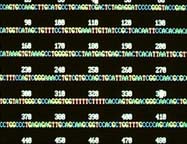Latest News

Help for names’ sakes
Shared names prompt good deeds.
When seeking help from a stranger, ask someone who shares your name: people are more likely to assist a namesake, an e-mail study has revealed 1 .
A shared name indicates two people are likely to share genes, so evolution may have taught us to be nice to our namesakes, suggests psychologist Margo Wilson who carried out the study at McMaster University in Hamilton, Ontario, Canada.
Unusual names are particularly good a

Antarctic Ice Core milestone – 2002 m reached as year 2002 arrives
In the first weeks of the New Year a team of European scientists drilled successfully through 2002 metres of ice at Dome Concordia, high on East Antarctica`s plateau – one of the most hostile places on the planet. A specially created laboratory on the ice enabled scientists to analyse, for the first time, past climate shifts within hours of each 3 m length of core being drilled – rather than waiting months or years for detailed study back in European labs. The team, working on a seven-year Antarctic

Uprooting and replanting the tree of life
A new theory on the evolution of ancient microbes is set to challenge widespread scientific views of early life on earth and could overturn previous interpretations of the huge bank of molecular taxonomic data that has been built up in recent years, according to research published today in the International Journal of Systematic and Evolutionary Microbiology.
“I`ve reinterpreted fossil records to show that eukaryotes, which includes plants, animals and fungi, are only half as old as previous

Genome exposes buried bugs
Knowing the human genetic sequence helps unearth invaders.
Human DNA is a new device for disease detectives. The database of human genetics can expose misfit microbe genes in diseased tissues, a US team have found.
Matthew Meyerson, of the Dana-Farber Cancer Institute in Boston, and his colleagues compared 7,000 DNA sequences extracted from cervical cancer cells to the vast database of human genes – and pulled out two misfits. Both were from a virus known to cause the cancer

CORDIS offers new service on the future of European research
CORDIS, the European Commission`s Research and Development Information Service, is offering a new online service dedicated to science and technology foresight and the future of European research. The service is part of the re-launch of a redesigned and upgraded CORDIS `Research beyond 2002` site to reflect the latest developments on both the European research area (ERA) and the Sixth Framework programme (FP6).
Technology Foresight
The new service provides information on res

Perforating aircraft wings with minute holes could make for more efficient flying
One way to make aeroplanes fly more efficiently is to drill millions of tiny holes in the leading edges of the wings. Like the dimples on a golf ball this has the effect of reducing drag. However, producing these holes on a manufacturing scale is not yet commercially feasible.
Researchers at Heriot-Watt University, funded by the Engineering and Physical Sciences Research Council, and the aerospace company BAE SYSTEMS, have carried out a series of fundamental studies on drilling such holes











